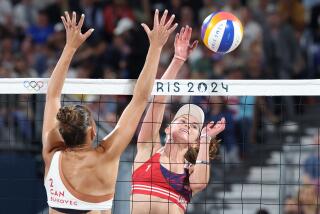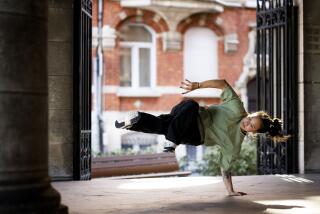THE REAL GAME OF BADMINTON : This Bears Little Resemblance to Your Average Family Party in the Backyard
- Share via
To most Southern Californians, badminton--if they think about it at all--is a game played in the backyard with family and friends. The best player often is holding a drink in one hand as he or she casually swats the feathered shuttlecock across the net.
That backyard concept has helped bury the United States as a force on the international badminton scene. Around the world, badminton, like soccer, is big. In countries such as China, Indonesia, Denmark and England, championship matches are played in major arenas and attract as many as 40,000.
In the United States, for an international match such as this weekend’s U.S. Carlsberg Open at the Manhattan Beach Badminton Club, the attendance is more likely to be 450.
Badminton enthusiasts, however, see a breakthrough for their sport in much the same manner that gymnastics became popular after 1972 when Olga Korbut was the darling of the Munich Olympics. Badminton will be introduced as a demonstration event in the 1988 Olympics at Seoul, South Korea, and will become a regular part of the program in 1992 at Barcelona, Spain.
“Exposure, especially on television, and money are what’s lacking in our program,” said Ted W. Helwig, chairman of the U.S. Badminton Assn.’s national development committee. “When Americans get a good look at the way the game is played internationally, I think it will be a shock to them. A pleasant shock.
“And by getting in the Olympics, badminton will begin to enjoy the financial support that the other Olympic sports receive. At the moment, all we have is what we get from commercial sponsors.”
The caliber of play that will be seen from Seoul on TV next year can be seen in person this weekend in the U.S. Open, where play started Wednesday and will conclude with finals Sunday.
The game is as different from the backyard variety as picnic softball is from World Series baseball.
The dexterity and quickness of the players as they slam or dink the cork-and-feather shuttlecock back and forth across a net five-feet high can be electrifying in its explosiveness. With a flick of the wrist, some of the better players hit the shuttlecock at speeds up to 100 m.p.h., yet still control its direction so that it drops into a corner of the court, which measures 44 by 20 feet. The badminton crowd maintains that it makes tennis look slow and dull.
“We run more in an hour than tennis players do in four hours,” claims Helen Troke, the British and European champion from Southampton, England. “In the Wimbledon finals between Boris Becker and Kevin Curren a year ago, the match lasted 3 hours and 38 minutes, but the ball was actually in play only 18 minutes. In the world badminton final that year, the match lasted 1 hour and 16 minutes, but the shuttlecock was in play for 37 minutes.”
Troke, who turned 23 last Saturday and was No. 1 in world Grand Prix points before snapping her Achilles’ tendon last year, continued: “Each point in their tennis match averaged 3 1/2 shots per rally. In the badminton final there were more than 13 shots per point, and there was none of that standing back and hitting from the baseline like a lot of the women do in tennis.”
With that, Troke stifled a make-believe yawn to display her feelings toward the “other” racket-and-net sport.
After being sidelined 10 months with an injury she suffered in a match in Japan, Troke is testing her still sore ankle this week. To maintain the sharpness in her game while in a wheelchair for months, she hit birds tossed by her coach for hour upon hour.
“I’ll find out what kind of shape I’m in this week,” she said. “This is one of the strongest U.S. Open fields ever.”
Players from 16 nations are competing at the 50-year-old Manhattan Beach facility. Not surprising, the top seeds are two South Koreans, Park Sung-Bae in the men’s singles and Lee Young-Suk in women’s singles.
The first seeded Americans are Chris Jogis of Palo Alto, a senior at Arizona State who is No. 7, and Tariq Wadood, a native of Pakistan and graduate student in mechanical engineering at Cal State Northridge, who is No. 8. Wadood lost to third-seeded Hiroki Eton of Japan in the quarterfinals.
There were no U.S. women seeded, and none even reached the quarterfinals.
Not since Dave Freeman of Pasadena in the 1940s and Judy Devlin Hashman of Baltimore in the 1960s has an American ranked at the top of the world in badminton. Things got so bad in the U.S. Open that the badminton association created a separate national championship for U.S. citizens only, or foreigners who had lived here a year or more.
It didn’t seem right, they reasoned, when the U.S. champion was an Asian named Channarong Ratanaseangsuang, the 1964 and 1968 winner.
“The Orientals changed the game,” said Rodney Barton, the 1983-84 national champion who grew up in Palo Alto playing with Jogis. “They play with a much quicker tempo, more upbeat. They keep more pressure on an opponent, they keep him from his own game plan. They don’t mind the heat because it’s hot where they come from and they have unbelievable stamina.
“Before they began to dominate the sport, badminton was a slower-paced game and, unfortunately, it still is in the United States except for a very few of the top players. Our image is still that of an outdoor, recreational game instead of a professional international sport.”
Even at the highest level, the Americans are struggling. For instance, in the latest USBA rankings, two of the top three men players are foreigners now living here.
Wadood, who came from Pakistan two years ago after virtually retiring as a professional player in 1984, is No. 1, followed by Jogis and Yao Ximing, a former People’s Republic of China phenom as a Canton teen-ager before he injured his back. Yao now confines most of his play to doubles with Wadood as his partner.
Yao, who won the All-Asian singles championship at 17, lives in Manhattan Beach and is studying English at the South Bay Adult School. In 1982, he was a member of the world championship Thomas Cup team--badminton’s equivalent of tennis’ Davis Cup--that defeated Indonesia in the finals at Wembley Stadium in London.
The plight of the Americans was never more apparent than at the 1987 World Championships in Beijing, China, where Jogis, the U.S. champion, lost in the first round.
“I met one of the top 10 players in the world in the first round because Americans don’t rate any consideration in the draw,” Jogis said. “The big thrill there was having my match on TV with my name in Chinese characters. The sport is so big in China that all 120 hours were on television, and there are only two channels so a lot of people had to see it.
“The entire game is different at that level and when you come back to the United States, if you’re not careful, you revert back to the U. S. level. It’s frustrating, but the only way I can see it changing is to get more quality players from here so we can raise our game to the international level.
“My dream is to get to the Olympics, but there is no guarantee that the United States will receive an invitation in 1988, when only a limited number of players will participate in the one-day exhibition. I would think that if we got one spot, though, I would get it if I can retain my ranking. So many things can happen before 1992 that I try not to look that far ahead.”
In an attempt to improve play in the United States, Wadood and Yao were recruited earlier this year to coach the national team.
“Right now, we are doing our coaching at the Manhattan Beach club, but in 1989, when badminton will be on the Olympic schedule, we will become part of the Olympic development program at Colorado Springs,” Wadood said. “That should be a big asset for the growth of the sport in the United States.”
When that time comes, Wadood will face a difficult decision: To return to Pakistan and use his mechanical engineering education or remain in this country to help lift the badminton program to an international level.
More to Read
Go beyond the scoreboard
Get the latest on L.A.'s teams in the daily Sports Report newsletter.
You may occasionally receive promotional content from the Los Angeles Times.






